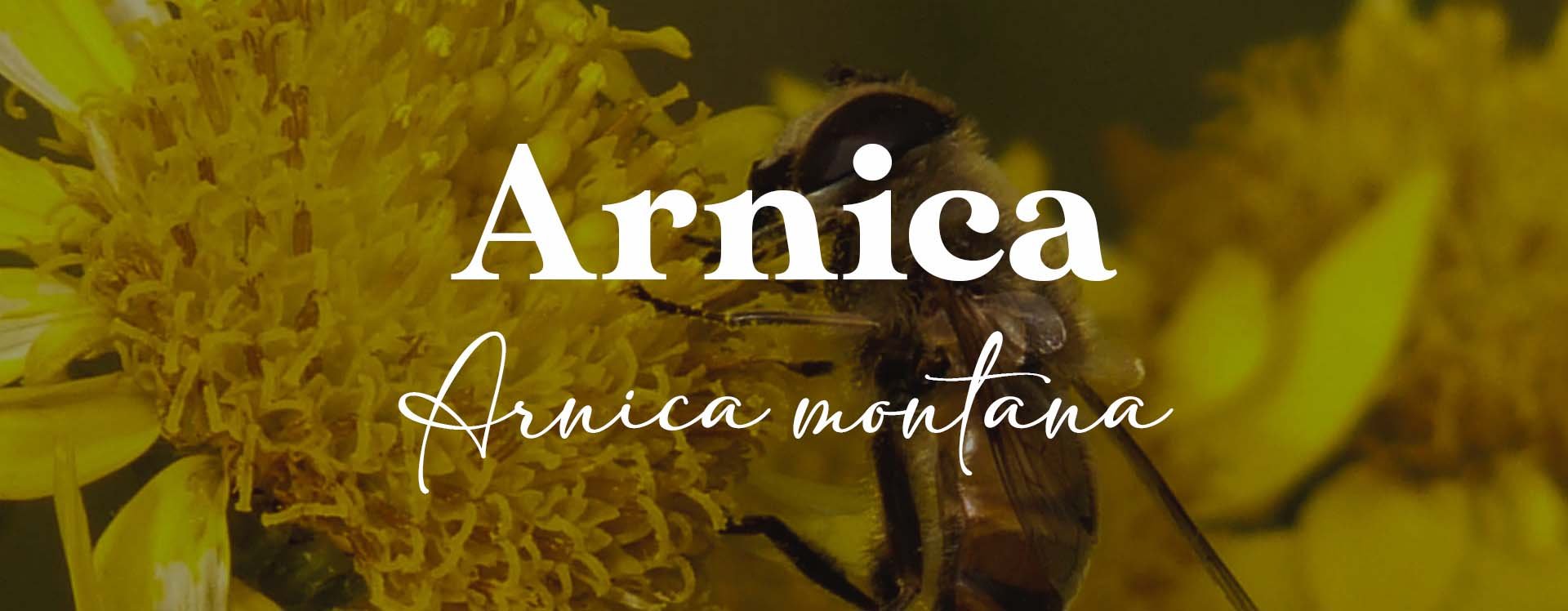Arnica (Arnica montana)
by Daniel Powers, MS
Arnica is a widely used plant used traditionally to treat various ailments.
It has especially been used for external healing when applied as a salve. It's well known for helping to speed up recovery time for bruises, sprains, and other soft tissue complaints.
Arnica is also used internally as a homeopathic remedy. This monograph will focus on the traditional external application of the herb.
Common Names: Leopard's bane, wolf's bane, mountain tobacco, fall-kraut, and sneezewort.
Description & Taxonomy: Arnica's scientific name is Arnica montana L. It's a herbaceous perennial in the Asteraceae (daisy) family.
This monograph will focus on the American varietal of Arnica, keep in mind that there is also a European subspecies of Arnica called A. montana ssp. atlantica. Both of these plants are similar and can be used interchangeably.
If interested, there has been some research put into learning more about the differences between the American and European subspecies, which you can learn more about here.
It grows 1–2 ft tall with dark green leaves, hairy stems, and bright yellow daisy-like ray flowers. The ray flowers’ teeth size is generally between 1-2mm long. The flowers appear in July and August with 1–7 flower heads (1).
Arnica grows at altitude and is often found in mountain valleys throughout North America, Europe, and northern Asia.
History, Ethnobotany, and Folklore
The name 'arnica' was given to this plant in the 1100's by the medieval healer Hildegard von Bingen who wrote about this plant in her work entitled "Physica".
It's thought that the word 'arnica' was derived from the Greek word ‘ptarmika’ which refers to something that causes sneezing (1).
Traditionally, Arnica has been used as a popular remedy for sprains, bruises, swellings, injuries, and wounds. Typically Arnica was used for soft tissue injuries that didn't involve broken skin (i.e. cuts and scrapes) (2).
Typically Arnica has been used externally, however, there is documented internal usage, especially within the German homeopathic tradition.
According to Engels & Brinckmann, in 1987 Germany’s Commission E approved the external use of arnica flowers for soft tissue injuries. They also approved of a homeopathic form of Arnica, a type of medicine where the plant is highly diluted, for internal complaints including inflammation of the oral and throat region, boils, inflammation caused by insect bites, and superficial phlebitis (3).
All of that said, generally Arnica has been used for external wounds where the skin has not been broken. This is the safest, most effective way to utilize this herb.
Parts Used: Typically the flower head. Though some traditional sources utilize the root (which was dug up in the fall) (4).
Cultivation, Harvest, & Sourcing
Growing Arnica: Arnica grows best at an altitude of 1500–7,500ft. It thrives in a soil mixture of loam, peat, and sand. When planting Arnica, it should be noted that seed germination is below 80% and can take up to a month to germinate (1).
Arnica can be cut before flowering to keep stems short and after flowering to produce secondary blooms. It's said that the Arnica chamissonis variety of Arnica is easier to grow and does better at a lower altitude.
Harvest: The best harvesting time for the flowers is in June– August. It's best to harvest midmorning after the morning dew has evaporated.
Endangered Status: This species is considered endangered in several different European countries, including: Bosnia-Herzegovina, Croatia, Slovenia, Germany and Lithuania, Luxembourg, Sweden, Romania, Balkans, Spain and Hungary (1).
Buying from a cultivated source is the best practice as wildcrafted European sources can be problematic.
Herbal Actions: Anti-inflammatory, vulnerary.
Constituents: It's estimated that one hundred and fifty therapeutically active phytochemicals are present in A. montana.
Highlights from this include sesquiterpene lactones (specifically arnifolin, arnicolides, & helenalin), flavonoids, volatile oils (including thymol), phenolic acids, coumarins, resins, bitters (arnicin), tannins, and carotenes (5).
Medicinal Use: The primary traditional usage for Arnica is as a topical ointment for bruising, muscle repair, and pain management. This traditional practice still holds today as Arnica creams are commonly sold and used for speeding up soft tissue repair.
In fact, Arnica is one of the best topical agents for soft tissue repair.
A meta-analysis was conducted that showed that Arnica is more effective than placebo when used for the treatment of several conditions including post-traumatic and postoperative pain, edema, and ecchymosis (6).
It should be noted that the above-mentioned meta-analysis looked at both topical and homeopathic (internal) forms of Arnica.
A 2002 study showed that Arnica gel helped to reduce pain stiffness in individuals with moderate osteoarthritis (of the knee) (7).
Another clinical study compared Arnica head-to-head with ibuprofen in individuals with osteoarthritis. The study concluded that Arnica had similar effects as ibuprofen. This study also found that Arnica was easier to take and had fewer adverse events (8).
A 2014 study found that Arnica gel helped to reduce pain after intense exercise (9).
Cautions and Contraindications
Safety Class: 3 (internal use, only to be used under the supervision of an expert), 2d (external use, not for use on broken skin)
Interaction Class: A (no clinically relevant reactions are expected)
In general, Arnica is safe when used externally on unbroken skin. Some individuals may have allergic reactions to Arnica (especially if they have known allergies to other plants in the Asteraceae family) (10).
When using for the first time, use only a small amount and see how your skin responds. Arnica should not be used for prolonged application.
Arnica should not be taken internally (unless taken in a homeopathic form). When taking as a homeopathic, follow instructions on the label closely.
Dosage and Method of Delivery:
Ointment: Typically contains 15% "Arnica Oil"; apply 2-3 times per day.
Lotion: Dilute a 1:5 arnica tincture by five times with water and apply 2-3 times per day.
Conclusion:
Arnica has been used in traditional medicine for centuries and it has powerful pain-alleviating properties.
Modern research shows that this herb may be an effective natural remedy for relief from arthritis or soft tissue injuries.
If you're looking for an all-natural way to manage your pain or sore muscles, consider trying out arnica.
Want more herbal goodness?
🌼Sign up for the HerbRally newsletter and receive these THIRTEEN herbal freebies!
VIDEO | Most Vital Herb in David Hoffmann’s First-Aid Kit
WEBINAR | Herbal First Aid with Heather Irvine
EBOOK | 86 Page Plant Healer Book
30 DAYS FREE | HerbRally Schoolhouse
EBOOK | Calendula for Radiant Skin by Rosalee de la Forêt
VIDEO | 5 Herbal Events Around the World presented by Bevin Clare
BOOK DISCOUNT | The Essential Guide to Western Botanical Medicine
PRIVATE COMMUNITY | HerbRally Facebook Group
BOOK EXCERPT | 36 Pages from Plant Healer's "Nourishing Foods" Book
DISCOUNT | 15% off all Mountain Rose Herbs products
DISCOUNT | Mushroom Revival
AUDIO | Hour-long Adaptogens Class with Heather Irvine
DISCOUNT | 10% off all HerbRally products
👉 CLAIM YOUR FREEBIES!
Daniel Powers, MS
Daniel is a graduate of the Maryland University of Integrative Health with a master's degree in Herbal Medicine. He has a passion for herbal medicine and how it can be used to support everyday health & wellness. You can read more of his work at https://botanicalinstitute.org/
References:
Kriplani, P., Guarve, K., & Baghael, U. S. (2017). Arnica montana L. - a plant of healing: review. The Journal of pharmacy and pharmacology, 69(8), 925–945. https://doi.org/10.1111/jphp.12724
Bone, K; Mills, S. (2013). Principles and Practice of Phytotherapy. Elsevier Health Sciences.
Engels, G., & Brinckmann, J. (n.d.). Arnica: Arnica montana. Arnica - American Botanical Council. Retrieved October 12, 2021, from https://www.herbalgram.org/resources/herbalgram/issues/107/table-of-contents/hg107-herbpro-arnica/
Grieve, M. (1931). Arnica. A Modern Herbal | Arnica. Retrieved October 12, 2021, from https://www.botanical.com/botanical/mgmh/a/arnic058.html
Hoffman, D. (2003). Medical herbalism: The science and practice of herbal medicine. Healing Arts Press.
Iannitti, T., Morales-Medina, J. C., Bellavite, P., Rottigni, V., & Palmieri, B. (2016). Effectiveness and Safety of Arnica montana in Post-Surgical Setting, Pain and Inflammation. American journal of therapeutics, 23(1), e184–e197. https://doi.org/10.1097/MJT.0000000000000036
Knuesel, O., Weber, M., & Suter, A. (2002). Arnica montana gel in osteoarthritis of the knee: an open, multicenter clinical trial. Advances in therapy, 19(5), 209–218. https://doi.org/10.1007/BF02850361
Widrig, R., Suter, A., Saller, R., & Melzer, J. (2007). Choosing between NSAID and arnica for topical treatment of hand osteoarthritis in a randomised, double-blind study. Rheumatology international, 27(6), 585–591. https://doi.org/10.1007/s00296-007-0304-y
Pumpa, K. L., Fallon, K. E., Bensoussan, A., & Papalia, S. (2014). The effects of topical Arnica on performance, pain and muscle damage after intense eccentric exercise. European journal of sport science, 14(3), 294–300. https://doi.org/10.1080/17461391.2013.829126
Gardner, Z., McGuffin, M. (2013). The botanical safety handbook [2nd edition]. American Herbal Products Association.




